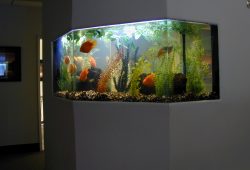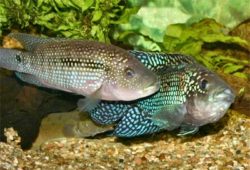Fish Tank Aquarium Problems – No 1 Sudden Fish Deaths
The following article is about Fish Tank Aquarium Problems – No 1 Sudden Fish Deaths. Once you’ve set up your fish tank aquarium and added your fish you sit back to enjoy your new hobby. Aquarium care is not difficult but some problems often arise, especially in newly set up tanks. It all looks perfect for a while then slowly algae starts to grow and overtake the tank, the fish begin to die and your new aquarium looks nothing like the clear, sparkling fish tanks you see in the pictures. So what did you do wrong? And more importantly what can you do to set it right?

First of all don’t panic and definitely don’t rush off to your local pet shop, buy chemical remedies and throw them into your tank. This will only compound the problems! Another thing that new fish keepers tend to do in a panic is to completely clean out the tank to start again. This is completely the wrong thing to do as any beneficial bacteria that you have in the tank will be completely destroyed and you will have to re-cycle the tank all over again.
What you do need to do is understand what is going wrong and slowly put it right, without harsh chemical treatments which will upset the balance of your fish tank even more. Read on for some of the more common problems that tend to afflict new tanks and how to deal with them.
Contents
Build up of Toxic Chemicals
The most worrying problem is when your fish suddenly die. Did you take the time to cycle the tank before you added the fish? The most common cause of fish dying suddenly is a build up of ammonia or nitrites from their waste products. You’ll need a fish tank aquarium test kit to properly check if this is the problem.
If you didn’t properly cycle the tank there won’t be enough of the bacteria needed to deal with these toxic waste products especially if you have a lot of fish. See Setting up a Fish Tank Aquarium – Fishless Cycling for how to cycle a tank correctly. Do you have too many fish in the tank? This will put a strain on the bacteria dealing with the waste and again increase the ammonia and nitrite levels. It is very tempting when in the pet shop to buy too many fish!
Bullying Fish
Did you mix peaceful fish with bullying types who are now hounding the other fish to death! Some fish are peaceful when young but can turn into bullies when fully grown. Tiger barbs are notorious for being bullies. They look very petty and many people are tempted to buy them to add to a community tank but there’s a good reason they are in their own tank in the pet shop!
Lack of Water Changes
Have you been partially changing the water at least once a week? Although ammonia and nitrites are dealt with by the bacteria they convert these into the less toxic nitrates. That is ‘less toxic’ not ‘non toxic’. If nitrate levels get too high they will harm the fish and the only way to lower the nitrate levels is to partially change the water.
Adding chlorine or chloramine contaminated water
All tap water contains chlorine which can be removed by allowing the water to stand for a day or two. Some authorities also add chloramines which can’t be removed this way. If your tap water contains chloramines, or you don’t know, you need to use a chemical to remove them before adding the water to the tank. These chemicals are both very toxic to the fish. See Fish Tank Water Chemistry for more information.
Overfeeding
Overfeeding is a common problem and results in decaying food which releases toxic chemicals that put an extra burden on the bacteria. The results is a sudden increase that can harm the fish. Overfeeding can also lead directly to fish deaths as fish eat when there is food available and don’t have our ability to know when they are full! They can continue to eat until their stomach swells enough to cause death.
Remedies
Test the water for ammonia and nitrites. These should be zero. If not do a partial water change of about 20%. As a routine change about 10% of the water weekly and about 30% once a month. Never replace more than 50% of the water or do a complete clean out as this will destroy the bacteria that deal with these wastes. Test the water at least weekly, more often if you are having problems and do a partial water change when the levels start to climb. If you have overstocked the tank consider giving away some of the fish!
When feeding tropical fish make sure you give them no more than they can eat in about 3 mins. If you see food sitting on the bottom of the tank you’ve added too much!



